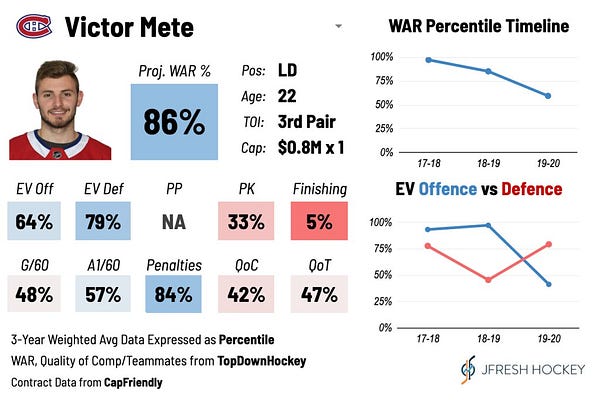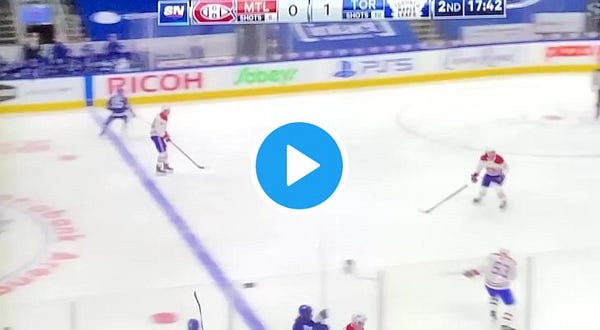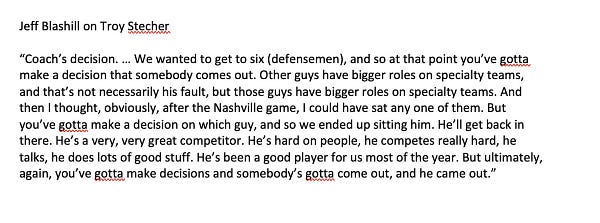Development plan: Victor Mete
Exactly one week ago, the Ottawa Senators claimed Victor Mete on waivers from the Montréal Canadiens. After moving four defensemen (Reilly, Gudbranson, Coburn, Wolanin) at the trade deadline, it was a great opportunity for them to claim a 22 years old NHL regular defenseman with strong on-ice results:




After three games with the Sens (small sample size), Mete's results have been good with his new team as well, according to Natural Stat Trick (54.00 xGF%, 80% SCF%, 62.50% HDCF%, positive CF% relative, etc).
In this piece, I'll take a look at a development plan for Mete to take the next step and establish himself as an NHL regular for his new team. When I read or talk with people about what Mete needs to improve, people always mention shooting and physicality in battle. While these are true, in players' development, it's way more beneficial to use Guy Boucher's 80/20 approach, in my opinion. Basically, it's about focusing 80% of the time on the strengths of the player (or things that could potentially become strengths) and 20% on weaknesses (to bridge the gap).
Using this approach, here's what my focus (in the 80%) would be for Mete's development:
1- Defending aggressively in the neutral zone (skating forwards)
2- Beating F1 (and attract F2) on puck retrieval or when moving the puck in transition
3- OZ activation
*2.1 and 3.1- Adding more deception in his game would help Mete do 2 and 3 more consistently**
Shooting and physicality would be in the 20% because these two won't be in Mete's strength as a player, so the main focus should be on other things.
1- Defending aggressively in the neutral zone (skating forwards)
According to hockey analyst Mikael Nahabedian data's (who does great work tracking Habs' players zone exit and zone entries against), Mete has not been one of the top Habs defensemen in defending zone entries.
With his great skating, Mete's at his best when defending aggressively in the neutral while skating forwards. It allows him to: 1- Get the puck back in transition to play to his strengths and 2- Limit defensive zone time defending for a smaller defenseman.
On the same shift, we can see Mete doing a great job defending while skating forwards in the neutral zone. In both cases, Ottawa are back in transition with the puck. Great work:
2- Beating F1 (and attract F2) on puck retrieval or when moving the puck in transition
As we can see in Andy & Rono's overall player rating, Mete's transition game is a strength, thanks to his skating. Mete's speed and skating allow him to be a great puck carrier, as we can see in these clips:


Where I'd like to see Mete improve in puck movement/transition to make him a dominant transitional defenseman is to more often beat F1 before moving the puck. When you beat F1 (with your feet or deception), then you attract F2. Now, if you move the puck, your team is in a numerical advantage (4v3). That's how high-end offensive defensemen create offense.
In this sequence, it's not a bad play, but it creates no numerical advantage. Mete retrieves the puck and makes a D2D pass (beat no one) to a static Jeff Petry. All Leafs' players are above the puck so the Habs have no space to make a play:
In a scenario like this, I'd like to see Mete uses his great skating to cut the net. F1 (Barabanov would be beaten), then a F2 would come and put pressure on Mete. Now Mete can move the puck and the Canadiens would have a numerical advantage. In my tweet about Romanov and Mete, Romanov does a great job of applying this concept. We can see him beating/attracting Engvall and Vesey before moving the puck. Mete jumps in to carry with his great skating and gains the inside dots for more options.
2.1- Deception
Deception (hip pocket, feet direction, head/shoulder fake, etc.) is a great way to freeze/slow down F1. By adding more deception in his game, Mete would be able to use his great skating even more to escape from F1. Here's an example against the Leafs where he could have used deception to beat F1. As he retrieves in the NZ, the puck is in a great position for Mete to fake a backhand pass up the wall (bringing Tavares' feet in this direction), then quickly cutting back to his strong side in the middle for a controlled play:
3- OZ activation
With his great skating abilities, I'd encourage Mete to activate as much as he can in the offensive zone, with or without the puck on his stick. By activating even more (he does it already), he would improve his playmaking by having more passing options than when a defenseman is on the blueline. Blueline shooting is not one of the best way to create offense to begin with, and with Mete's shot as a weakness of his game, getting in better scoring area would make him more of a scoring threats.
In this sequence, we can see Mete activating without the puck and with the puck with the Senators. In both scenarios, he creates a strong offensive opportunity for the Sens:
In this one, we can see offensive zone time from Mete with the Habs, staying on the blueline (can be a system and/or confidence thing as well) instead of activating and looking for better opportunity:
Adding more deception would help Mete in point 2 and 3. Also, tracking microstats on zone entries against, on below the circle zone-exit retrievals and on offensive zone touches & activation are all great and simple ways to track progress in these areas.
Bonus section: Special units
Rightfully or not, many coaches like to have defensemen with special units skills in their bottom four, even if their 5-on-5 on-ice impact are not as good:


With only six defensemen playing regularly in a lineup, it's important that most of them can contribute either on the PP or PK (or both). If the Sens can give an opportunity to Mete to play on a special unit, it can be huge for his development and ability to stay in an NHL lineup. As of now, the Sens have Chabot and Brännström on their PP, so it's hard for them to include Mete on their man advantage. They are probably giving him some PP reps in practice in case something happen and there's an opportunity. As for the PK, Mete's result haven't been great in Montréal (as we can see on JFresh’s players card), but he's still really young and there's no reason why he shouldn't improve in this area. As of now, the Sens haven't use Mete on the PK, but it's only been three games and they probably want him to adjust to his new team and get comfortable at 5-on-5 first. But down the road, I'd like to see them give Mete an opportunity on their PK (maybe alternating 50/50 with Brännström). I'm not saying Mete will ever be a primarily PPQB or PK'er, but if he can be a third QB options and a #4/5 PK'er, it could be great for his versatility.
Conclusion
I'm a believer in Mete's upside. He already has demonstrated good things at the NHL level and there is potential for more. The Sens have a solid young defenseman with great skating and good compete to work with. As we can see in the clips and the data, Mete is already doing some of the things mentioned in these three focus points (that's why they are in the 80%). Confidence and systems/tactics are also probably part of it. By being in and out of the lineup in Montréal, his confidence was probably lower so it's always a reflex to look for the safe play to limit mistake instead of trying to beat F1 or activating in the OZ. The Sens are in a position (standings) where they can let him make plays all over the ice to improve his ability to be more dangerous offensively. If he can add details/layers/fine-tuning to become dominant in these three aspects, Mete's identity as a player will be even more clear (great in transition by carry and by passing, dangerous in the OZ, aggressive defending in the NZ to get back in transition) and his weakness (shot, board battles) will be hidden (he would be in better location to create offense and would spend minimal time defending in his zone).
Clips powered by In Stat hockey







